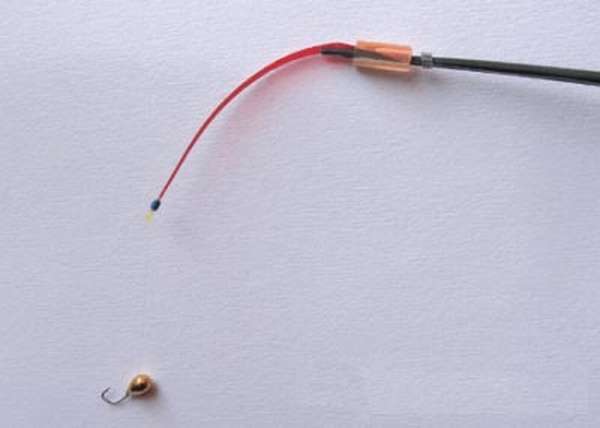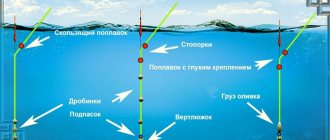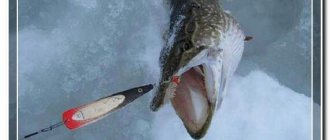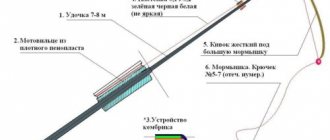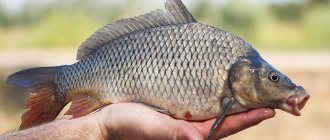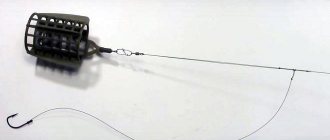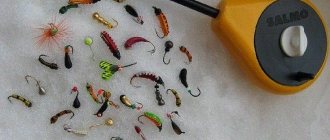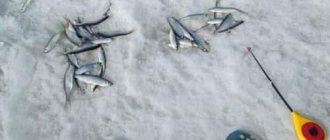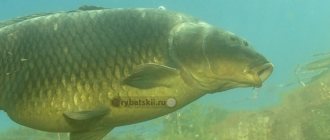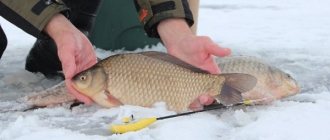If summer fishing can be called “horizontal” based on the method of presenting any bait, then in winter, until you find fish under your feet by lowering the bait from top to bottom into the hole, there will be no bite.
Winter fishing is vertical fishing. Based on this, all the refinements are carried out in the selection and play of jigs, spinners, balancers, etc. Fishing vertically in a plumb line involves moving the bait only up and down. And since the peculiarities of national fishing in winter paralyze the movements of baits to some extent, it is much more difficult to arouse the interest of fish with an unnaturally jumping bait. You have to constantly change the amplitude of vibrations, the speed of swinging the fishing rod, selecting a catchy game. Spinner baits that go some distance away from the vertical with a displaced center of gravity and balance beams that perform pendulum-radial oscillations do not change the essence of the matter.
Lessons on playing with a balalaika fishing rod
Winter fishermen will immediately understand what we are talking about. For the uninitiated, let me explain: a “balalaika” is not a stringed instrument, but a winter fishing rod with a nod and a reel, without a handle. It received this name for its external similarity with a folk instrument. The balalaika is held in the hand by the reel. The vibrations that animate the bait are created by the movement of the hand (small-amplitude “trembling”) and the entire arm (sheer lure). You can and should combine both the first and second movements, working with any winter bait. In the first option, the jig moves no more than one or two centimeters, in the second, layers up to one meter high or more are fished, with a smooth rise and fall of the bait.
To give very fast vibrations, the nod is held at the tip between the index and thumb of the other hand. When choosing a bait game, you need to look not only for the appropriate amplitude of trembling and swings, but also the speed of movement up and down, pauses between them. It is quite difficult to describe the game of a professional. It's better to see once than to read a hundred times. It’s worth taking a close look at the hands of a successful fisherman. Not only what he fishes with, but also how he fishes. That is, his game is bait. Otherwise, even if you, fortunately, find a similar jig in your arsenal, there may not be success. Incorrectly selected bait will scare away both perch and roach.
At the beginning of the winter season, each time you have to “train your hand” again. Over the summer, skills are a little forgotten. In order not to waste time fishing, but at the same time to see how the newly acquired jigs move in the water, it is worth spending a couple of evenings testing them. To do this, you will have to rent a bathroom from your household.
A bathtub filled with water is used even in industrial production, by such “oligarchs” in the production of artificial baits as RAPPALA and Mann`s. So it's serious. In a calm environment, in a warm bathroom, to carefully examine and remember the game of each jig - this means acquiring your own personal experience, irreplaceable by any articles you’ve read.
There are only two limitations to “bathtub” experiments: the shallow depth of the bath (only 40-50 centimeters), and the kind of jig play that will interest the real fish under the hole, and not you in the bathtub. And yet, such tests provide visual perception (and therefore understanding) of the movements of baits in the water and refresh the muscle memory of the hand for playing winter fishing tools.
The second stage of improving your playing technique, whether you like it or not, will have to be carried out in the field. Directly in the hole. There are so many more interesting discoveries you can make for yourself. Especially explain the reason for the escapes, under-hooking, weak bites and ignoring the bait.
Nod for jig fishing
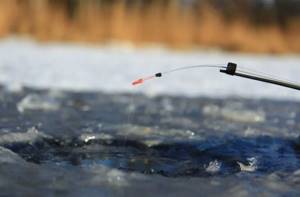
The nod on a winter fishing rod is considered the main component of successful jig fishing. It not only serves as a bite alarm, but is also responsible for the correct play of the jig.
Nods for fishing in the winter months can be purchased in stores. They have different shapes, lengths and hardness. Nods for jig fishing are made from a variety of materials. The most popular are models made of lavsan or steel strip.
Dacron models are characterized by increased sensitivity. They do not freeze or rust. In addition, nods of this type are capable of transmitting even the slightest movements of the jig. It is advisable to use them when fishing in a special polyethylene tent or on small rivers and lakes where there is no strong wind.
Models made from a metal spring have less sensitivity, but at the same time they are very sensitive to the wind, which makes it possible to distinguish a fish bite from its gusts.
Fishing with a jig will have a successful result if the elasticity and length of the nod correspond to the weight of the jig and the nature of the game with it.
Playing jigs underwater
So, the solo numbers are over. Having shaken all the baits in a shallow bath, it’s time to go on the big stage, so to speak. I mean, a hole. As Vladimir Barakov says: “Let’s watch cartoons.” Let's look into the hole, lowering the jig there. For field experiments to be successful, they must again be continued alone.
Neighbors crunching felt boots on the ice, and, even worse, drilling holes, will be a significant nuisance. Moreover, you collect ridicule at yourself: “they say, he’s already lying down in the morning, look, he’s lying down over the hole.” Let's leave our neighbors in the dark about the true reasons for looking at the emerald depths. To see deeper, the hole must be darkened by tightly clasping your face with your hands. I won’t encourage you to put on a diving mask and look into the hole with the viewing glass submerged in the water, but this way you can see the bait at even greater depths. So, if you want, twist your finger at your temple, if you want, improve your qualifications.
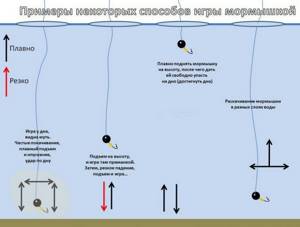
What will be visible in the hole? Ooh! This is truly a spectacle worthy of old W. Disney! Sometimes you laugh so hard, skating on the ice, from the perches staring blankly at the jig. At the same time, your fishermen neighbors make fun of you, and you make fun of yourself and your neighbors, realizing how stupid you look, squatting on the ice and laughing into the hole. It’s like reading jokes to yourself on a crowded bus while shedding tears. Wow, a picture! Cinema, and nothing more!
Playing a jig in the current
Filming underwater fishing for perch with a devil
Read also: Fishing with a devil
The reaction of perch and roach to playing with a jig
First, the perches begin to pull themselves up to the hole, then they freeze near the jig that has hypnotized them. Small ones are closer, large ones are further away. They butt heads for a long time about who should start. Either the smartest, or the most beautiful. At some point in the jig game, the first, cautiously inaccurate attack follows, a miss. Let's wonder why.
We change the game and pauses in the game with bait. After the first bite, you can take a normal position and start fishing like everyone else, or you can continue to look at the underwater inhabitants. I do this in order to understand how to motivate the perches to actively bite. Find a way to lower the jig so that natural greed, or rather food competition, takes over. And then you can carefully sit on the box without exposing the hole. The whole flock will peck to the last, both smart and stupid, both small and large.
If a perch can look at the bait for half an hour without deciding to bite, then the roach acts completely differently. You lie on the ice, looking into the hole. No one. You throw in a lump of breadcrumbs with bait bloodworms. At the limit of visibility, near the bottom, the bloodworm, as if by magic, disappears right before our eyes. The roach attacks the food quickly. Why, then, are her bites so soft, lingering, or, more precisely, “thievish.” The roach does not swallow food like a perch, which either tries to bite (if the bait is large) or immediately swallow it (if the bait is small). She hits the bait, barely touching it with her thin lips. The roach has a small mouth, and as soon as it grabs the food, it either tries to pull it off the hook, or retreats back home with a tasty morsel. Having seen all this with your own eyes on an underwater TV, it becomes clear what a roach bite is and why it is easy to distinguish it from a perch.
What are the differences between the best jigs for fishing?
Any jig is divided not only according to the principle of suspension on the line, but also, first of all, according to its shape and weight. In addition, baits vary in material and color. There are a huge number of them on sale, but fishermen are constantly inventing something new.
The weight of the jig and the depth of fishing are collective concepts. Due to their small size, baits are cast from metal alloys whose specific gravity is several times higher than the weight of lead. These metals include tungsten, thanks to which a small jig can be immersed to a considerable depth.
In addition to tungsten, there are products made from lead, stainless steel, tin, copper, and brass. They are used depending on the situation. For example, tungsten sinks quickly enough into the water column, so the waiting time is significantly reduced. If another metal is available, then at greater depths you will have to use larger baits.
When going out to a body of water, a fisherman must have a sufficient number of them in his arsenal to find the one he needs that can bring a decent catch. Various equipment, which we wrote about in the article “Various methods of installing winter fishing rods regardless of fishing technology,” are also important.
If you try to divide the jigs by mass, you will get the following picture:
- the weight of the smallest is no more than 0.4 g;
- the mass of the average is in the range from 0.5 g to 1.0 g;
- over 1.0 g are considered heavy.
Fishing with a jig can also be done according to its size, the smallest of which is no larger than a match head, and the largest one exceeds 4 mm in cross-section. Their shape is also very diverse - drop-shaped, faceted, flat-oval, conical, spherical. It is impossible to predict which of them will work in a given situation, which is why the supply must be decent.
What is the jig fishing technique?
Fishing with jigs involves not only changing baits depending on the bite activity, but also taking a selective approach to fishing tactics. Management techniques can vary dramatically depending on many factors. For example, today it is possible to catch fish with active play, tomorrow – with sluggish play.
- The bait is placed on the ground of the reservoir for a couple of seconds, then it is raised, shaking, by two tens of centimeters. Trembling can be caused by tapping the rod with your finger.
- As in the first case, the game starts from the ground of the reservoir, however, the amplitude increases to 10 millimeters. Every five centimeters the bait should freeze, then rise again. Having reached a certain height, the equipment begins to be lowered in a similar way. It is not recommended to simply release the bait, otherwise it will scare away the fish.
- While telling the secrets of fishing with a jig, we will mention another method - tapping the bait on the ground, which allows you to stir up the water and attract curious fish. To drag along the bottom, the fishing rod is led from one edge of the hole to the other.
- Sometimes the fish greedily rushes to the bait, which is lifted from the bottom with an acceleration of about half a meter.
- If you hold the line between your fingers and force it to rotate around its axis along with the bait, this can provoke the fish to attack.
- Fishing with a fishing rod using a jig may involve another technique: the bait is made to oscillate quickly, then raised higher and the operation repeated.
All these techniques can be combined with each other, achieving the optimal effect. If you can’t wait for a bite, then you should think about changing the bait. Fishing with a jig on the river involves walking fishing, so you should move around as much as possible to find a catchy spot.
Where does fishing begin, how to tie a jig
Connecting a line with a bait is not so difficult, although there are many ways of tying and knots. In addition, the installation method largely depends on the type of bait, which can be with a ring or a hole. There can also be two jigs on the rig.
If the weight has an eyelet, then the knitting sequence is as follows:
- First of all, we thread the line through the ring;
- we wrap the missing line around the main one;
- We pass the tip through the loop at the bottom and pull it by the central line.
This method is not suitable for rewinders, since the eye is located in a vertical plane, so you can use another method:
- we pass the line through the eye;
- fold the tip in half;
- We apply the double line to the fore-end and wrap the free end of the line around it;
- We pull the tip into a loop and tighten it.
In this way you can tie to earless baits that have only a small hole. However, many anglers prefer a simpler method. Fishing with a baitless jig in this case becomes successful, since it hangs at an angle of 45 degrees in relation to the forest.
The line is inserted into the hole from above, since the tip should always point in the direction opposite to the bottom of the reservoir. At the end there is a loop through which the scaffolding is threaded twice so that the knot does not unravel under load. Then it is twisted in a figure eight, folded in half and put on the forend. Tighten - it's done.
"Documentary film about pike"
But the most exciting sight that I had the opportunity to peep through the round ice window was bites, or rather attacks, squinting, weighing 600-700 grams. They liked my balancer. Once again, looking at the humorous perches, I decided to scare them with a balance beam. I’ll explain why it’s scary now. The fact is that if you catch with a jig, then the perches behave calmly and are not at all afraid of a small shiny “flea”. When a fairly large fish, 3-5 centimeters in length, falls on top of them, the striped robbers scatter.
If you immediately start playing with a balance beam, the perches most likely will not bite. They have absolutely no idea where the fry of the “parrot” color came from here. It is better to put the balancer on the bottom for a while and wait until the cloud of turbidity settles down after it lands on the bottom soil. After some time, the perches return. And you can start playing carefully, first weakly, then swinging the balancer more and more. The perches will not be able to tolerate such disgrace for long. The bravest will definitely go to intercept.
The same picture happened that time. Suddenly the perches seemed to be blown away. I paused the rhythmically yawing balance beam. What happened next took no more than a second. The flashing gray back pulled the bait, caught the lower tee, and began to twist convulsively, opening its mouth. I instantly and mechanically pulled the line out of the water to the full length of my arm. He brought the fish to the hole, and, in the absence of a hook, put his left hand up to the elbow into the hole. The pike immediately cut my fingers with its sharp teeth, and for complete balance in the fight, it attached one of the hooks of the balancer to my index finger. Scarred in such an original way, she was pulled out onto the ice, amid a loud cry and strong interjections.
After slobbering and wrapping my pierced fingers, I moved from the ill-fated place to a hole located about thirty meters away, closer to the reeds. He lowered the balance beam and lay down on the ice. I didn’t notice the next pike right away; its muzzle barely peeked out from under the snag. I lifted the balancer from the bottom and shook it a little. And then I saw in detail how pike hunt in winter.
Peeking out from under a snag on one third of the hull, the spotted torpedo began to slowly turn around and crawl out from under its cover, like a submarine from a dock. No noticeable movements or bends of the body - straight as an arrow. Saving precious energy and not making unnecessary movements, the pike took a position: sideways to the bait. I slightly stopped the pendulum oscillations of the balancer. Of course, I didn’t have time to see the attack itself. But I guarantee that it happened on a U-turn.
Moreover, having bitten the balance bar, the pike immediately stopped its body movements, swimming only by inertia. A second later, having appreciated the gastronomic features of the balancer, she began to try, like her predecessor, to get rid of the hooked fish. I didn’t want to be stained again. My hand was already aching. And it seems like I’m catching, but I’m not being caught. Then my comrades arrived with a hook. I led the predator to the hole and hooked it with its tip by the lower jaw. And he pulled it out. Strictly vertical.
Active jig
We discussed stationary ice fishing with fishing rods in the current in the article at the link provided. Here we will analyze active fishing for the game with one fishing rod, with constant control of the gear. The bottom line is that fishing conditions should be divided into two types - depending on the ability to control the bottom with the gear used for fishing. In weak currents (or medium currents with shallow depths), you can work with the usual gear, including baitless bait, only heavier (from 0.5 grams). In strong currents, a heavy sinker is included in the rig. The game is played by tensioning and releasing a loop of fishing line, inflated by the current, without lifting the heavy sinker from the bottom (in place) or by releasing it (pull) under the ice. By the way, it is advisable to use these two fishing methods on the same gear.
